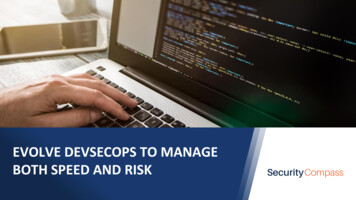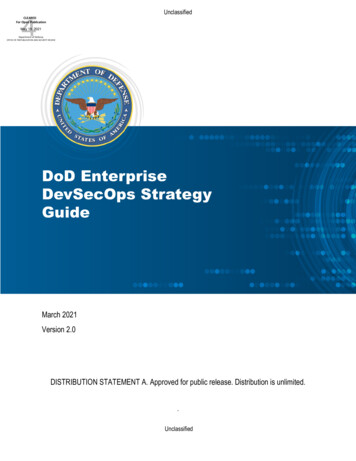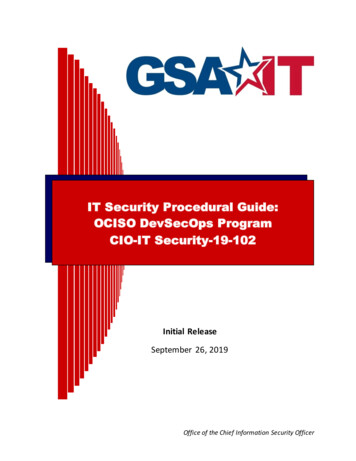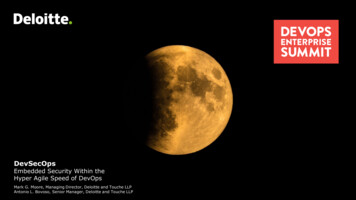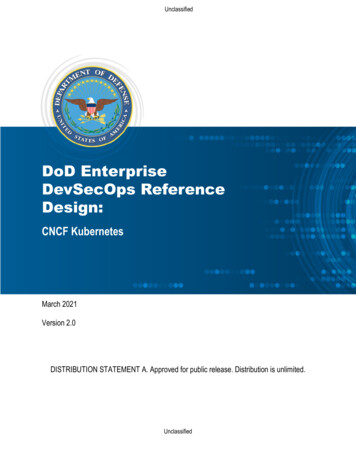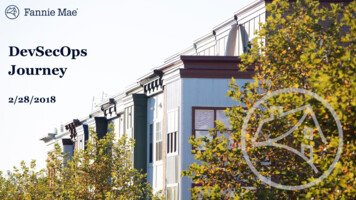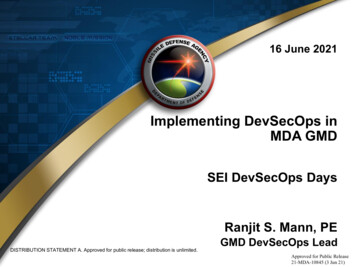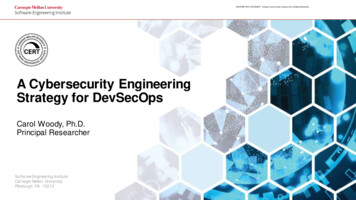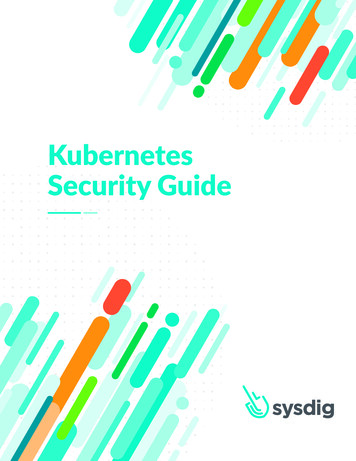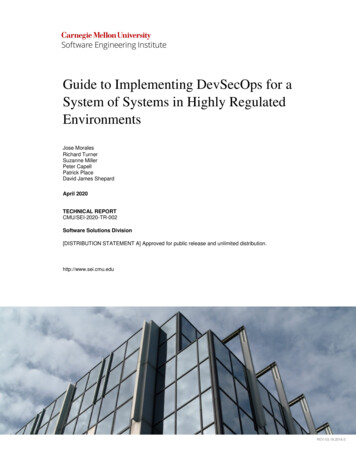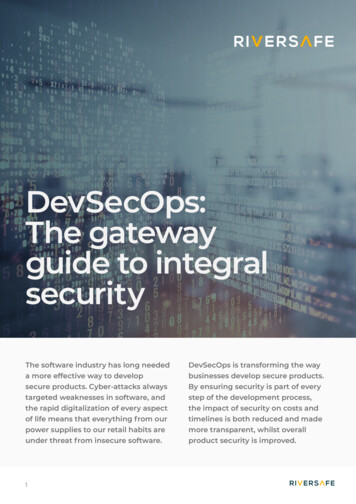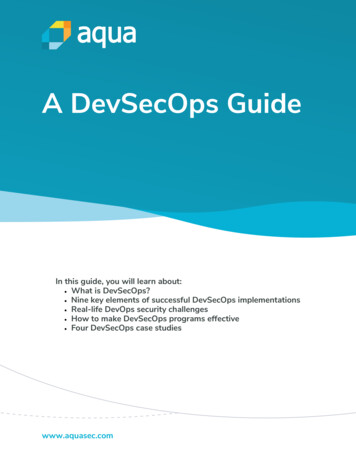
Transcription
A DevSecOps GuideIn this guide, you will learn about: What is DevSecOps? Nine key elements of successful DevSecOps implementations Real-life DevOps security challenges How to make DevSecOps programs effective Four DevSecOps case studieswww.aquasec.com
Table of ContentsDevSecOps: Making It Happen 3What is DevSecOps? 4DevSecOps and Container Technology 5Other Common DevOps Practices 5DevSecOps: Shifting Security Left 6Real-Life DevOps Security Challenges 7The Skills Gap 7Serverless Security Issues 7Container Security Risks 8Cloud Deployment Risks 8Legacy Application Security Risks 8Nine Key Elements of Successful DevSecOps 9Four DevSecOps Case Studies 11DevSecOps for Cloud Native with Aqua Security 13www.aquasec.com
DevSecOps: Making It HappenAfter understanding the value of a DevOps mindset, making the culturalshift and reaping the benefits, many companies are aiming for the nextbig step: integrating development, operations, and security into oneorganization.However, DevSecOps programs are ambitious and challenging to carryout. Organizations have to manage their resources, tools, cultural andstructural changes. This guide explains how DevSecOps programsare implemented in organizations of all sizes and in different verticals,discusses real life challenges faced by organizations making thetransition, and provides stories and lessons you can learn from thoseorganizations. We hope this will help you take a big step towardssuccessful implementation of DevSecOps inyour organization.www.aquasec.comA DevSecOps Guide 3
What is DevSecOps?DevSecOps extends the advantages of a DevOps approach, including agility andresponsiveness, to IT security. The idea is to integrate security early in the developmentprocess and throughout the Software Development Lifecycle (SDLC). This involvesfostering a culture of flexibility and ongoing collaboration between development andsecurity teams, and incorporating security protocols into the development process.To illustrate, here is a typical DevSecOps workflow:Commit - a developer creates code in a repository and commits their changesAnalyze - Another developer pulls the code from version control and performsstatic analysis or peer review to identify security issues or other bugsSetup Environment - If the code passes static analysis, an environmentautomatically spins up, deployed in containers with configuration managed byInfrastructure as Code toolsTest - The build system executes a test suite, including unit tests, functionaltests, UI automation tests, integration tests, and also security testsDeploy - If all the tests pass, the new version is promoted to aproduction environmentMonitor - The new production version is monitored to identify security threatsRepeat - Upon identification of a security issue requiring changes to thesoftware, or any other bug or feature request, a developer creates a new versionof the code and commits it to repository, restarting the cycle.www.aquasec.comA DevSecOps Guide 4
DevSecOps and Container TechnologyContainer technology is an important facilitator of DevSecOps: It is predictable and easy to automate, enabling fast development anddeployment cycles Containers are immutable infrastructure, which makes it easier to identify attacksand recover from them when they are compromised Containers make it possible to redeploy updated images frequently - making iteasier to remediate security vulnerabilities Containers allow teams to shift left, deploying applications automatically andbuilding security testing into the build process, instead of waiting to apply securityonly after deploymentOther Common DevOps PracticesOther practices common in DevSecOps organizations include: Integrating code analysis tools into the development pipeline, to preventcompromised code from reaching production Automating and continually testing the production environment to detectweaknesses Carrying out fixes and patches before deployment, not after Automated or semi-automated security gates that enable careful review ofsoftware without slowing down the workflowwww.aquasec.comA DevSecOps Guide 5
DevSecOps: Shifting Security Left“Shift left” is an approach to software testing in which tests and fixes are performedearlier in the development pipeline - “more to the left” when looking at a lifecycle diagramthat flows from left to right. It enforces the agile principle “test early and often” bybuilding testing into all stages of the SDLC.In DevSecOps, it is security testing and remediation that shifts left. The core concept ofDevSecOps is to address security at all stages of the delivery chain, from requirementsand planning to development, testing, deployment and release. The goal is to improve thecoverage and effectiveness of security processes, increase software quality, shorten testcycles, and reduce the security debt.Most importantly - it is easier and less expensive to apply security fixes as early aspossible in the cycle. Just like it is exponentially cheaper to fix bugs the earlier you catchthem in the development process.All of the above sounds great on paper, but implementing it is a different matter. In theremainder of this article we’ll dive into what it takes to really implement DevSecOps,common challenges organizations run into, and lessons from real-life success stories.www.aquasec.comA DevSecOps Guide 6
Real-Life DevOps Security Challengesand Overcoming ThemDevOps teams that attempt to take ownership of security and make the transition toDevSecOps, find it is a complex and risky undertaking. Here are a few of the obstaclesstanding in the way of many DevSecOps transitions and what you can do about them.The Skills GapMost engineers and operations experts aren’texperts in security, and security analysts have limitedunderstanding of development processes, tools andtradeoffs. In a DevSecOps organization, complementingeach of these groups with the opposite skill hastremendous value. Developers understand security bestpractices and can start implementing them in every task.Security teams can make more informed suggestions,understanding the implications of specific changes to thesoftware or the environment.Serverless Security IssuesServerless architectures, also called Function as aService (FaaS), allow you to execute and scale businesslogic without worrying about the runtime environment,storage and operating system. The serverless provideris responsible for the security of cloud infrastructurecomponents, which reduces the security burden placed onthe user, but doesn’t eliminate it. Your security prioritieswill need to shift to risks such as unsecured serverlessdeployment configuration, unsecured storage, overprivileged function permissions and roles, inadequatefunction monitoring, denial of service (DOS), and financialresource exhaustion by hijacking your own workloads fornefarious purposes (e.g., mining for crypto-currency).www.aquasec.comA DevSecOps Guide 7
Container Security RisksContainers facilitate consistent deployment of applications,but they raise some new security challenges. Transientcontainers and microservices are difficult to monitor,while misconfiguration of container networking can leaveyour production environment vulnerable. Containers areoften used to break down applications into microservices,which increases data traffic. Traditional server securitysolutions don’t support containers; consider specializedsecurity technology that can lock down containers withsafe configuration, scan images to ensure they are safe,and monitor containers in production. One such solution isAqua’s Cloud Native Security Platform.Cloud Deployment RisksDevOps relies on cloud technology to automate and scaledev/test/production workflows. However the cloud raisesnew security challenges, including cloud account hijacking,misconfiguration of cloud resources, which can bedangerous if those resources are exposed to the Internet,privileged account abuse which can lead to massive dataloss, and insecure or compromised APIs, which are thebasis of all cloud integrations.Legacy Application Security RisksSecurity administrators often overlook legacy systems,allowing vulnerabilities to go unchecked. Legacysystems are prone to vulnerabilities and patches mustbe continuously applied, but in some cases updatesmight break the legacy system. The presence of legacyapplications can disrupt DevSecOps programs; legacyapps can create security threats, but they are difficult toadapt to an automated DevSecOps cycle.www.aquasec.comA DevSecOps Guide 8
Nine Key Elements ofSuccessful DevSecOps ImplementationsOvercoming the key challenges above is only one part of the story. Ensure you addressthe following best practices in your DevSecOps project:Integrate automated testing into the pipeline—integrate securitytesting into the build and deployment process. Test the security of yourinfrastructure in real-time, or as close to it as possible. To save time, youcan automate simple security tests, for example vulnerability scans. Youcan use automated acceptance tests, known as functional security tests,to verify that features like authentication and logout are working properly.You should choose a testing framework that integrates easily with yourCI/CD server, and that your development, security, and ops teams canuse comfortably.Integrate security testing into workflows—there are several types ofsecurity testing you can build into your development process. Theseinclude code analysis tools like Veracode, which can find vulnerabilities inyour code and in open source libraries, cloud security tools like MicrosoftAzure Advisor which can advise you on cloud security best practices, andtools for securing container and serverless workloads, alike.Automated deployment—automation is crucial to continuous deliveryworkflows. Create a deployment model to manage and orchestratedeployment activities, control variability, and reduce errors. Be faithful tothe principle that security should happen before deployment, not after- build security checks and security lock-downs into your deploymentprocess, making it impossible to deploy a non-secured environment.Infrastructure as Code (IaC)—you can use IaC alongside continuousdelivery to manage infrastructure, such as virtual machines and networks.Leverage IaC to control and test installation and deployment processesand ensure they are in line with security practices. Security and ops staffshould review and approve configuration flows.www.aquasec.comA DevSecOps Guide 9
Continuous monitoring—tracking systems in production can contributeto all sides of the DevSecOps triangle. Monitoring can identify securityissues and help you resolve them early to prevent incidents in production.Continuous, proactive monitoring helps you improve user experience inproduction while avoiding expensive rollbacks. Monitoring can also assistdevelopment by including integration and acceptance tests to ensure theapplication works as intended while it is running in production.Immutable infrastructure provisioning—immutable infrastructure,like containers, are servers that you don’t modify after deployment, asopposed to traditional mutable infrastructures in which you continuallymodify servers. Immutable infrastructure is more consistent, reliable, andpredictable, and makes deployment simpler. If you need to fix or updatesomething, you can build new servers to replace the old ones, which arethen decommissioned. This mitigates issues like snowflake servers andconfiguration drift.Remediating application security vulnerabilities—have clear remediationplans that you can deploy immediately to eliminate vulnerabilities.When using open source software, integrate automated open sourcemanagement tools to keep you up-to-date with known vulnerabilitiesand calculate the associated security risk. These tools cross-referencecomponents with an updated database and list vulnerabilities accordingto priority. Remediate vulnerabilities fast by applying quick, temporaryfixes, virtual patching solutions, patching software components,modifying configuration, and using runtime defensive technologies likefirewalls or Runtime Application Self-Protection (RASP).Train engineers in Secure DevOps—Security Awareness Training (SAT)ensures that the development team is familiar with industry standardsand can identify, assess, and respond to security issues. Training providesemployees with a better understanding of their responsibilities, improvestheir confidence and performance, and reduces the risk of a breach. Atraining program can also help foster team cooperation and consistency.Use secret management tools—secrets embedded in source code andfound throughout the DevOps pipeline present a significant security risk.Secrets can be passwords, credentials, tokens, or keys. DevSecOps teamsmust use tools that securely manage and store secrets. They should alsoimplement access controls that don’t affect the automated workflowsof DevOps.www.aquasec.comA DevSecOps Guide 10
Four DevSecOps Case StudiesAllianz, PayPal, the National Institute of Allergy and Infectious Diseases (NIAID), andMaersk are four organizations operating development and operations on a huge scale,who decided to make the transition to DevSecOps. If they could make it happen,anyone can.As a large company, Allianz had trouble ensuring that everyone took responsibility forsecurity and the process for fixing vulnerabilities was slow. Despite having a large inhouse IT organization, it was difficult to create automated testing tools and remediationplans. Security was outsourced, making it difficult to upgrade Allianz’s infrastructure.Allianz implemented CloudBees, a continuous delivery platform, to help automate theirsoftware development. They also incorporated pen-testing into their DevSecOps processso developers could produce secure code and fix security vulnerabilities quickly. Allianzhad to alter the culture of their workplace, which included training their team with a focuson security engineering, threat modeling, and business risk assessment.With over 254 million active account holders conducting billions of payment transactions,PayPal had to find a way to guarantee security at scale. The company planned itstransition to DevSecOps with a timeline of less than a year, shifting from a project-drivenmindset to a product-aligned approach and prioritizing usability and security.To help guide the organization through this process, PayPal assigned “ChangeChampions” and “Transformation Team Members”. They created actionable securitystories and replaced security lingo with language the development team couldunderstand. They gave autonomy to developers to implement approved security controlsand established patterns, providing secure code snippets and offering clear usageguidelines.PayPal developers create 1 million builds per month, which would be virtually impossiblewithout automated security scans and the flexibility afforded by theDevSecOps methodology.www.aquasec.comA DevSecOps Guide 11
The National Institute of Allergy and Infectious Diseases (NIAID) conducts medicalresearch and uses sensitive health data that must be protected. NIAID faced challengesregarding the consistency and predictability of their data, and they found it difficult toincorporate specific, consistent security policies into a systematic framework. However,their first priority was a cultural change.NIAID updated their security protocols and implemented infrastructure-as-code (IaC)practices, which make application and server configurations inspectable and help reducevulnerabilities. NIAID also integrated Fortify, a security scanning tool, into their pipeline toprevent the introduction of coding vulnerabilities.After a cyber attack infected their network in 2017, Maersk had to rebuild their core ITcapability in a matter of weeks. This involved reconstructing their server and networkinfrastructure, updating their global operating system, and restoring their entireapplication stack. To accomplish this, the shipping company focused on reorganizing andstandardizing its digital environment, implementing a new common standard for over60,000 devices.Maersk made risk governance a CISO function instead of a central corporate function,so the CISO is responsible for identifying infrastructure gaps and making and enforcingsecurity policies. The CISO makes decisions in consultation with business owners, whocan then decide how to address geographically limited risks.The supervisory board includes non-technical personnel. The company provides readableassessments of its security profile. For example, a funnel diagram represents securitydata in order of ascending importance, from the number of external surface attacks,through penetrations and security incidents, to major incidents.www.aquasec.comA DevSecOps Guide 12
DevSecOps for Cloud Native with Aqua SecurityAqua Security lets enterprises secure their cloud-native and container-based applicationsfrom development through to production. This is helping bridge the gap betweenDevOps and IT security and is driving container adoption.Aqua’s Container Security Platform offers transparent, automated security, including fullvisibility into container activity. Organizations can use this platform to find and preventmalicious activity and attacks. Aqua’s platform also helps organizations implementsecurity policies and simplify regulatory compliance.Organizations can use Aqua to automate the secure development and deploymentof applications in their DevSecOps pipelines. With Aqua, organizations can embedcomprehensive security testing and effective policy-driven controls early on in thedevelopment cycle. The process is fully automated, supporting a shift left strategy.www.aquasec.comA DevSecOps Guide 13
Aqua helps accelerate application delivery and remove obstacles to yourDevSecOps program: Image and function scanning—scans container images and serverless functionsfor embedded secrets, known vulnerabilities and malware, licensing issues andconfiguration problems. Continuous image assurance—stops unapproved functions and images frombeing deployed in your environment. It prevents image sprawl and roguedeployments, and preempts operational errors. CI/CD integration—natively integrates with Azure DevOps, Jenkins, Bamboo,TeamCity, GitLab, and most other tools in the DevOps toolset. Aqua scans imagesas they are developed and gives actionable feedback to developers within theirIDEs. Collaborative remediation—provides real-time actionable information ofconfiguration remediation and vulnerability, giving feedback to developers withintheir CI/CD tools, as a ticket in Jira or sent via Slack. Centralized secrets management—leverages your existing secrets vaults tosecurely deliver, rotate, and update secrets in containers. This is done with noexposure outside the container and no container restarts.Find out more about Aqua’s Cloud Native Security Platform.www.aquasec.comA DevSecOps Guide 14
Real-Life DevOps Security Challenges and Overcoming Them DevOps teams that attempt to take ownership of security and make the transition to DevSecOps, find it is a complex and risky undertaking. Here are a few of the obstacles standing in the way of many DevSecOps transitions and what you can do about them. The Skills Gap
